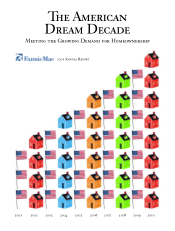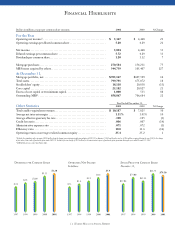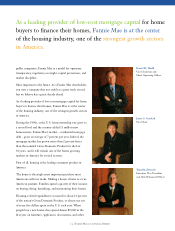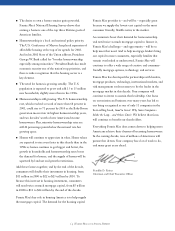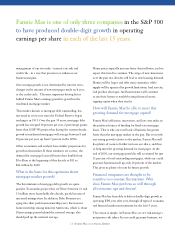Fannie Mae 2001 Annual Report Download - page 5
Download and view the complete annual report
Please find page 5 of the 2001 Fannie Mae annual report below. You can navigate through the pages in the report by either clicking on the pages listed below, or by using the keyword search tool below to find specific information within the annual report.
{ 3} Fannie Mae 2001 Annual Report
Daniel H. Mudd
Vice Chairman and
Chief Operating Officer
Jamie S. Gorelick
Vice Chair
Timothy Howard
Executive Vice President
and Chief Financial Officer
public companies, Fannie Mae is a model for openness,
transparency, regulatory oversight, capital protections, and
market discipline.
Most important is the future. As a Fannie Mae shareholder,
you own a company that not only has a great track record,
but we believe has a great decade ahead.
As a leading provider of low-cost mortgage capital for home
buyers to finance their homes, Fannie Mae is at the center
of the housing industry, one of the strongest growth sectors
in America.
During the 1990s, as the U.S. homeownership rate grew to
a record level and the country added 11 million new
homeowners, Fannie Mae’s market – residential mortgage
debt – grew an average of 7 percent per year. Indeed, the
mortgage market has grown more than 2 percent faster
than the nominal Gross Domestic Product for the last
30 years, and it will remain one of the fastest growing
markets in America for several reasons.
First of all, housing is the leading consumer product in
America.
The house is the single most important purchase most
Americans will ever make. Making a house a home is a true
American pastime. Families spend a quarter of their income
on buying, fixing, furnishing, and maintaining their homes.
Housing-related expenditures account for about 21 percent
of the nation’s Gross Domestic Product, or about one out
of every five dollars spent in the U.S. each year. When
people buy a new home, they spend almost $9,000 in the
first year on furniture, appliances, decorations, and other
As a leading provider of low-cost mortgage capital for home
buyers to finance their homes, Fannie Mae is at the center
of the housing industry, one of the strongest growth sectors
in America.

